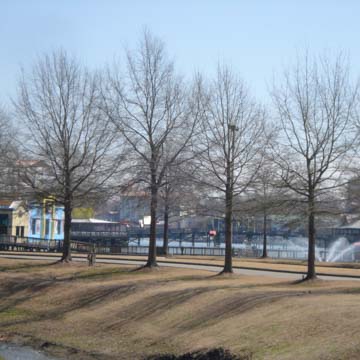Broadway at the Beach is South Carolina’s preeminent themed environment. It includes facilities devoted specifically to entertainment but, like a theme park, the complex as a whole uses design to transform all commercial and social activity within its perimeter into an endlessly flowing experience of entertainment.
Broadway at the Beach was created by Burroughs and Chapin, a South Carolina real estate concern that was formed in 1990. The firm and its predecessor, Burroughs and Collins, have played the leading role in the development of Myrtle Beach since the establishment in 1912 of an affiliate, the Myrtle Beach Farms Company. Like other South Carolina companies that found success in the twentieth century, Burroughs and Chapin have combined innovative and even aggressive business practices with cultural conservatism into strategies that have largely determined the social and physical shape of the state’s largest beach resort.
Burroughs and Chapin’s project for Broadway at the Beach emerged in the early 1990s at a time when Myrtle Beach’s original Recreational Business District, like many American downtowns since the 1960s, had fallen into decline. Like a competing local project very similar in concept, Fantasy Harbour on the Intracoastal Waterway, Broadway at the Beach was proposed for a site far from central Myrtle Beach. The 350-acre site on the newly established Highway 17 Bypass lay in Horry County but was annexed to the City of Myrtle Beach as part of an agreement to secure financing. In this way, the automobile-dependent project accelerated the sprawl of Myrtle Beach. Aiming at an upper-class clientele, it also fostered the resort’s transformation from a so-called “Redneck Riviera,” which catered to working- and lower-middle-class visitors, into one intended to appeal to vacationers with greater freedom to spend.
The concept underlying Broadway at the Beach owes much to the widely acclaimed projects completed in the late 1980s and early 1990s by the Jerde Partnership. Those projects, which gave architectural expression to the most advanced marketing concepts of their time, included Fashion Island at Newport Beach and Universal City Walk in Studio City (Los Angeles), California. Broadway at the Beach echoes the theming and non-axial organization of the former while implementing the notion of what Norman Klein called “scripted space,” pioneered by the latter.
Conceived as a mixed-use venue that combined opportunities to enjoy shopping, restaurant dining, and theatrical shows, Broadway at the Beach rose in three building phases completed between 1993 and 1997. There is a good deal of irony in the fact that Broadway at the Beach is not actually situated at a beachfront. Instead, it simulates being at the beach. Pegram Associates designed its thematic architecture to evoke a generic seaside village, affording both beach access and something like the experiences available in the theaters of New York’s Broadway theater district. An expansive, ocean-like water feature occupies the center of the complex, whose outer boundaries are surrounded by vast parking lots.
In the oldest part of Broadway at the Beach (Phase I), a boardwalk rings the central pool and functions like a single-loaded corridor running outside the shops and providing all visitors with direct visual access to water. Although the Phase I boardwalk remained proprietary space, its positioning allowed it to effectively mimic public space. In the later part of the complex, the designers allocated the waterside areas mostly to porches and decks accessible only through (leased) commercial premises, thus privatizing them. The “public” circulation areas now functioned only to channel traffic into areas of commercial transaction. These circulation areas meander so as to present multiple and changing vistas, thus giving a sense of free choice among possible next destinations—some near, some far—and affording options for modifying one’s path at any moment.
Broadway at the Beach opened on September 1, 1995, and featured a plaque dedicating it “To the Families of the World.” The venture allowed Myrtle Beach to capture a large segment of the family-oriented market, which had previously been drawn to Heritage USA (opened in 1978 and shuttered in 1989), South Carolina’s even larger, mixed-use, Christian-themed resort complex in Fort Mill, at the opposite end of the state’s northern border. Development of Broadway at the Beach and surrounding lands is ongoing and follows a strategy of functional diversification. As more and more chain companies have established themselves in purpose-built structures branded with their own architectural designs, the general effect has become increasingly eclectic. As a result, the identity of the complex has merged with that of greater Myrtle Beach as home to such themed franchises as the All Star Café, the NASCAR Café, Hard Rock Café, the Planet Hollywood restaurant, and the House of Blues. By 2006, commentators remarking on this transformation began referring to the extremely fast-growing, franchise-filled Myrtle Beach metropolitan area as “The Next Orlando.”
References
“Burroughs & Chapin Company, Inc.” International Directory of Company Histories86 (2007): 52-55.
Milliken, Helen . From the Beginning: A History of the Burroughs & Chapin Company. Myrtle Beach, SC: Sheriar Press, 2004.
Moredock, Will. Banana Republic: A Year in the Heart of Myrtle Beach. Charleston, SC: Frontline Press, Ltd., 2003.
Schoolfield, Jeremy. “The Next Orlando?” Funworld22, no. 4 (November 2006): 70-72, 75.
“Theme Hopping Down in Myrtle Beach.” Washington Post, July 3, 1997.














